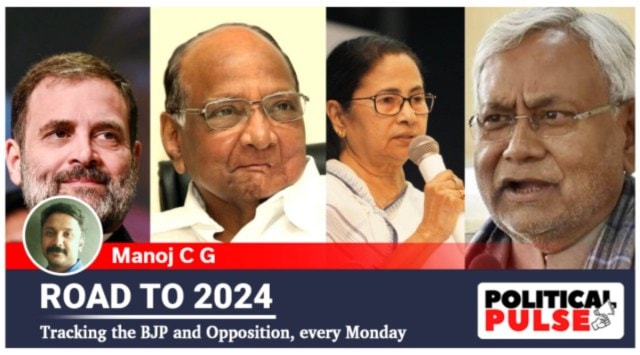Road to 2024 | The great Opposition unity plans, and the many imponderables
On the June 23 stage will be several parties which have jumped the fence several times, some which are still sitting on the fence, and some which think the fence should not contain them
 Top Opposition leaders will converge in Patna to begin discussions on formation of a broad front against the BJP on June 23. (PTI/file/Facebook: Sharad Pawar; Mamata Banerjee)
Top Opposition leaders will converge in Patna to begin discussions on formation of a broad front against the BJP on June 23. (PTI/file/Facebook: Sharad Pawar; Mamata Banerjee) ON JUNE 23, top Opposition leaders will converge in Patna to begin discussions on formation of a broad front against the BJP. For many parties, it is a political alliance of necessity in view of next year’s crucial Lok Sabha elections. For the opponents of some – such as Arvind Kejriwal, Nitish Kumar and Sharad Pawar – it is yet another turn by them in the art of political and personal convenience.
They point to Sunday’s return to the Ramlila Maidan in Delhi by Kejriwal, this time for a rally against the Centre’s ordinance for control of services in the national capital where, seated next to him, was Rajya Sabha MP and former Congress Union minister Kapil Sibal. As a Congress leader, Sibal was one of the top names in the Delhi Chief Minister and AAP supremo’s list of “corrupt”.
During the initial years of the Anna Hazare agitation, of which Kejriwal was a crucial part, and later, the AAP’s compilation of such names ran long. It is another matter that Kejriwal would go on to “apologise” to most of them to get out of defamation cases, including to Sibal and his son Amit. (Kejriwal had accused Amit of conflict of interest, saying he had appeared in court for a telecom firm while his father was the Communications Minister.)
The other leaders Kejriwal dubbed “corrupt” included Rahul Gandhi, several UPA ministers, the late Samajwadi Party supremo Mulayam Singh Yadav, NCP chief Sharad Pawar and former Jammu & Kashmir chief minister and National Conference leader Farooq Abdullah. As part of his efforts to unite the Opposition against the Centre’s ordinance now, Kejriwal has met Pawar and Mulayam’s son and SP chief Akhilesh Yadav.
Kejriwal has also done his share of somersaults in fighting the BJP on both nationalism and Hindutva fronts. When the BJP government scrapped Article 370, which granted special status to Jammu and Kashmir, and bifurcated the state into two Union territories, the AAP was one of the most vociferous voices in favour of the move.
Last week, NC leader Omar Abdullah raised this to suggest the NC could not be part of a joint Opposition front.
In fact, Nitish Kumar, the host of the conclave showcasing this unity, is an ace political trapeze artist himself, adept at swinging from one side to another and yet landing on his feet. He has stayed in power switching alliances from the BJP to the Opposition to the BJP, and back again.
Then, there is Pawar, the past master and survivor who has called the shots at the Centre for years now, despite the low numbers at his command. While proving a glue of the Maha Vikas Aghadi coalition in Maharashtra, the NCP chief keeps just enough room open to ensure both friends and enemies stay on the edge.
Another star Opposition face at the conclave will be Trinamool Congress chief Mamata Banerjee, whose blow hot, blow cold relationship with the Congress means no one can be sure where she will ultimately lean.
Lastly, there is the Congress itself which, at the heart of hearts, will find it very difficult to concede the prima donna space to any other party. Politics of necessity might have forced it to take a secondary spot in Tamil Nadu (to the DMK), Jharkhand (JMM), Maharashtra (NCP and Uddhav Shiv Sena), Bihar (JD-U and RJD) and West Bengal (Left) – not counting Uttar Pradesh, where it is finding it difficult to find friends – but the real test will be other states.
So while one joint candidate against the BJP on every seat might sound very promising on paper, this will run into problems almost immediately off it.
If some Congress leaders are to be believed, the party would like the unity discussions to be dragged till the end of the year, when elections will take place in four key states – Rajasthan, Madhya Pradesh, Chhattisgarh and Telangana – where no parties really stand between the BJP and Congress. As Congress leaders argue, a good showing in these elections will increase the bargaining power of the grand old party.
Perhaps for the same reason, many of the regional parties are keen that a broad framework is arrived at as early as possible.
There are two other parties that occupy largely the Opposition space but which have so far refrained from putting their bets on one horse – the Bharat Rashtra Samithi’s K Chandrashekar Rao and the BSP’s Mayawati.
In the past one year, KCR has moved from being a neutral fence-sitter to an acerbic BJP baiter to a wait-and-watch cautious stand now. Mayawati, after her great fall in Uttar Pradesh, only emerges once in a while to make a statement, before disappearing again.
- 01
- 02
- 03
- 04
- 05































